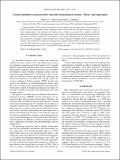| dc.contributor.author | Culpepper, Martin Luther | |
| dc.contributor.author | Cullinan, Michael Arthur | |
| dc.date.accessioned | 2011-01-28T18:57:28Z | |
| dc.date.available | 2011-01-28T18:57:28Z | |
| dc.date.issued | 2010-09 | |
| dc.date.submitted | 2010-08 | |
| dc.identifier.issn | 1098-0121 | |
| dc.identifier.issn | 1550-235X | |
| dc.identifier.uri | http://hdl.handle.net/1721.1/60855 | |
| dc.description.abstract | Carbon-nanotube (CNT) -based strain sensors have the potential to overcome some of the limitations in small-scale force/displacement sensing technologies due to their small size and high sensitivity to strain. A better understanding of the dominant and limiting causes of high strain sensitivity is needed to enable the design and manufacture of high-performance sensor systems. This paper presents the theoretical framework that makes it possible to predict the strain sensitivity of a carbon nanotube based on it chiral indices (n,m). This framework is extended to capture the behavior of sensors composed of multiple CNTs in a parallel resistor network. This framework has been used to predict that a parallel resistor network of more than 100 randomly selected CNTs should have a gauge factor of approximately 78.5±0.4. This is within the experimental error of the measured gauge factor of 75±5 for such CNT resistor networks. | en_US |
| dc.language.iso | en_US | |
| dc.publisher | American Physical Society | en_US |
| dc.relation.isversionof | http://dx.doi.org/10.1103/PhysRevB.82.115428 | en_US |
| dc.rights | Article is made available in accordance with the publisher's policy and may be subject to US copyright law. Please refer to the publisher's site for terms of use. | en_US |
| dc.source | APS | en_US |
| dc.title | Carbon nanotubes as piezoresistive microelectromechanical sensors: Theory and experiment | en_US |
| dc.type | Article | en_US |
| dc.identifier.citation | Cullinan, Michael A., and Martin L. Culpepper. “Carbon nanotubes as piezoresistive microelectromechanical sensors: Theory and experiment.” Physical Review B 82.11 (2010): 115428. © 2010 The American Physical Society. | en_US |
| dc.contributor.department | Massachusetts Institute of Technology. Department of Mechanical Engineering | en_US |
| dc.contributor.approver | Culpepper, Martin Luther | |
| dc.contributor.mitauthor | Culpepper, Martin Luther | |
| dc.contributor.mitauthor | Cullinan, Michael Arthur | |
| dc.relation.journal | Physical Review B | en_US |
| dc.eprint.version | Final published version | en_US |
| dc.type.uri | http://purl.org/eprint/type/JournalArticle | en_US |
| eprint.status | http://purl.org/eprint/status/PeerReviewed | en_US |
| dspace.orderedauthors | Cullinan, Michael; Culpepper, Martin | en |
| dc.identifier.orcid | https://orcid.org/0000-0002-8014-1940 | |
| mit.license | PUBLISHER_POLICY | en_US |
| mit.metadata.status | Complete | |
